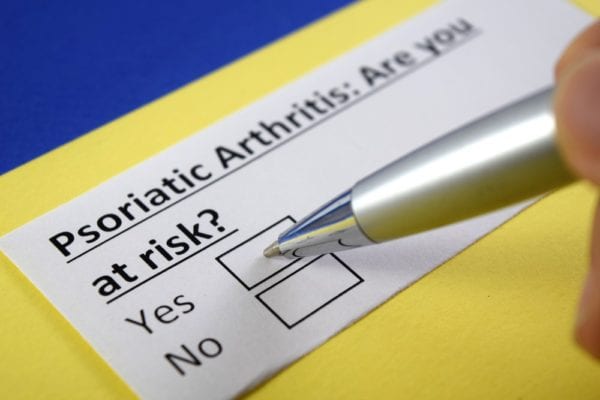
One of the least-known and most-misunderstood forms of arthritis that individuals suffer from today is psoriatic arthritis. This is an inflammatory form of arthritis that can lead to permanent joint damage if not diagnosed and treated as soon as symptoms arise. In fact, studies suggest that irreversible damage can occur if there is a diagnostic delay of just six months.1,2 Here is a broad overview of psoriatic arthritis and how it relates to dry skin symptoms and swelling of the fingers.
Symptoms of Psoriatic Arthritis
Psoriatic arthritis is a condition that often develops slowly, but the onset can come quickly with some patients.3 It often appears initially as just generalized fatigue and stiffness.
The fingers often swell and are described as looking like sausages.4 Other symptoms related to the swelling of the fingers include throbbing, tenderness, and reduced range of motion. Individuals with this condition may also see their nails separating from the nail bed.
Oligoarticular is the term used to describe mild psoriatic arthritis when it affects four or fewer joints in the body.5 More serious cases of the condition are referred to as polyarticular. Psoriatic arthritis can affect the hands, toes, arms, legs, or spinal column. But the type that causes inflammation and swelling of the fingers and toes is called dactylitis and is a distinguishing indicator of this type of arthritis.
Treatments for Psoriatic Arthritis
Rheumatologists are physicians who specialize in arthritis and are often best equipped to confirm a diagnosis of psoriatic arthritis.6 It is possible to be diagnosed with both rheumatoid arthritis and psoriatic arthritis and also gout and psoriatic arthritis, but these dual-arthritis conditions are very rare.
Medications are used to reduce inflammation and pain, and many of these medications are designed to treat both the joint condition and skin disease.3 Topical pain relief creams that are specially formulated for arthritis sufferers, like JointFlex, may also help psoriatic arthritis sufferers find relief.
If the body does not respond to initial treatment, physicians may explore disease-modifying anti-rheumatic drugs like sulfasalazine or methotrexate.7 Biologic therapies have also been used to block molecules and receptors that cause inflammation.3 In other patients, corticosteroid injections and surgery may be discussed.
Who Suffers from Psoriatic Arthritis
According to the National Psoriasis Foundation, approximately 30 percent of people with psoriasis develop psoriatic arthritis.1 Children are more likely to experience psoriasis and psoriatic arthritis at the same time than adults are. In some cases, the joint conditions that are caused by these diseases actually come before the skin conditions. Regardless of age, the development of psoriatic arthritis is affected by genetics, immune system functioning, and various environmental factors.
Ways to Prevent Psoriatic Arthritis Symptoms
Exercise is recommended for psoriatic arthritis sufferers to keep the joints and muscles active and flexible.8,9 Walking, swimming, yoga, and stretching are excellent low-impact ways to get moving without putting too much strain on tender joints. Cold packs can reduce swelling and ease pain, while a warm towel or bath can relax aching joints and muscles.
Some individuals find mobility tools, like canes and grab bars, useful in carrying out daily activities without putting undue stress on the joints. Reducing one’s sugar, red meat, and dairy consumption may help with the inflammation symptoms as well. Meanwhile, antioxidant-rich foods like spinach and blueberries can naturally strengthen the body’s immune system.
REFERENCES FOR WHAT TO KNOW ABOUT PSORIATIC ARTHRITIS
1. About psoriatic arthritis. National Psoriasis Foundation. Retrieved October 31, 2018 from https://www.psoriasis.org/about-psoriatic-arthritis.
2. Leavitt, M. (2015 May 6). Why early diagnosis is critical for psoriatic arthritis. National Psoriasis Foundation. Retrieved October 31, 2018 from https://www.psoriasis.org/advance/early-diagnosis-critical-for-psoriatic-arthritis.
3. Kontzias, A. (2017 July). Psoriatic arthritis. The Merck Manual: Consumer Version. Retrieved October 31, 2018 from https://www.merckmanuals.com/home/bone,-joint,-and-muscle-disorders/joint-disorders/psoriatic-arthritis.
4. Psoriatic arthritis. National Institute of Arthritis and Musculoskeletal and Skin Diseases. Retrieved October 31, 2018 from https://www.niams.nih.gov/health-topics/psoriatic-arthritis#tab-symptoms.
5. Psoriatic arthritis. U. S. National Library of Medicine. Retrieved October 31, 2018 from https://ghr.nlm.nih.gov/condition/psoriatic-arthritis.
6. Rheumatology is a specialty. National Psoriasis Foundation. Retrieved October 31, 2018 from https://www.psoriasis.org/psoriatic-arthritis/find-the-right-doctor/rheumatology.
7. Combination therapy often best for RA. Arthritis Foundation. Retrieved October 31, 2018 from https://www.arthritis.org/about-arthritis/types/rheumatoid-arthritis/articles/rheumatoid-arthritis-triple-therapy.php.
8. Bartlett, S. (2018 January). The role of exercise in arthritis management. Johns Hopkins Arthritis Center. Retrieved October 31, 2018 from https://www.hopkinsarthritis.org/patient-corner/disease-management/role-of-exercise-in-arthritis-management/.
9. Arthritis self management: What you need to know. Arthritis Foundation. Retrieved October 31, 2018 from https://www.arthritis.org/about-arthritis/understanding-arthritis/arthritis-self-management.php.
